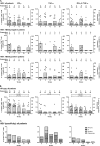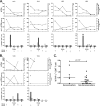No increase in hepatitis B virus (HBV)-specific CD8+ T cells in patients with HIV-1-HBV coinfections following HBV-active highly active antiretroviral therapy
- PMID: 20053751
- PMCID: PMC2826062
- DOI: 10.1128/JVI.02124-09
No increase in hepatitis B virus (HBV)-specific CD8+ T cells in patients with HIV-1-HBV coinfections following HBV-active highly active antiretroviral therapy
Abstract
Following treatment of hepatitis B virus (HBV) monoinfection, HBV-specific T-cell responses increase significantly; however, little is known about the recovery of HBV-specific T-cell responses following HBV-active highly active antiretroviral therapy (HAART) in HIV-HBV coinfected patients. HIV-HBV coinfected patients who were treatment naïve and initiating HBV-active HAART were recruited as part of a prospective cohort study in Thailand and followed for 48 weeks (n = 24). Production of gamma interferon (IFN-gamma) and tumor necrosis factor alpha (TNF-alpha) in both HBV- and HIV-specific CD8(+) T cells was quantified using intracellular cytokine staining on whole blood. Following HBV-active HAART, the median (interquartile range) log decline from week 0 to week 48 for HBV DNA was 5.8 log (range, 3.4 to 6.7) IU/ml, and for HIV RNA it was 3.1 (range, 2.9 to 3.5) log copies/ml (P < 0.001 for both). The frequency of HIV Gag-specific CD8(+) T-cell responses significantly decreased (IFN-gamma, P < 0.001; TNF-alpha, P = 0.05). In contrast, there was no significant change in the frequency (IFN-gamma, P = 0.21; TNF-alpha, P = 0.61; and IFN-gamma and TNF-alpha, P = 0.11) or magnitude (IFN-gamma, P = 0.13; TNF-alpha, P = 0.13; and IFN-gamma and TNF-alpha, P = 0.13) of HBV-specific CD8(+) T-cell responses over 48 weeks of HBV-active HAART. Of the 14 individuals who were HBV e antigen (HBeAg) positive, 5/14 (36%) lost HBeAg during the 48 weeks of follow-up. HBV-specific CD8(+) T cells were detected in 4/5 (80%) of patients prior to HBeAg loss. Results from this study show no sustained change in the HBV-specific CD8(+) T-cell response following HBV-active HAART. These findings may have implications for the duration of treatment of HBV in HIV-HBV coinfected patients, particularly in HBeAg-positive disease.
Figures



Similar articles
-
Quantitative HBsAg and HBeAg predict hepatitis B seroconversion after initiation of HAART in HIV-HBV coinfected individuals.PLoS One. 2013 Apr 9;8(4):e61297. doi: 10.1371/journal.pone.0061297. Print 2013. PLoS One. 2013. PMID: 23593455 Free PMC article.
-
Impaired quality of the hepatitis B virus (HBV)-specific T-cell response in human immunodeficiency virus type 1-HBV coinfection.J Virol. 2009 Aug;83(15):7649-58. doi: 10.1128/JVI.00183-09. Epub 2009 May 20. J Virol. 2009. PMID: 19458009 Free PMC article.
-
Long-term hepatitis B virus (HBV) response to lamivudine-containing highly active antiretroviral therapy in HIV-HBV co-infected patients in Thailand.PLoS One. 2012;7(7):e42184. doi: 10.1371/journal.pone.0042184. Epub 2012 Jul 31. PLoS One. 2012. PMID: 22860080 Free PMC article.
-
HCV-specific T-cell responses in HIV/hepatitis C virus-coinfected patients on highly active antiretroviral therapy are comparable to those observed in hepatitis C virus-monoinfected individuals.J Acquir Immune Defic Syndr. 2011 May 1;57(1):1-8. doi: 10.1097/qai.0b013e31821024e7. J Acquir Immune Defic Syndr. 2011. PMID: 21786458
-
A randomized trial of combination hepatitis B therapy in HIV/HBV coinfected antiretroviral naïve individuals in Thailand.Hepatology. 2008 Oct;48(4):1062-9. doi: 10.1002/hep.22462. Hepatology. 2008. PMID: 18697216 Clinical Trial.
Cited by
-
Elevated pre-treatment IL-18 level is associated with HBeAg seroconversion in HIV-HBV coinfection.Antivir Ther. 2017;22(6):523-527. doi: 10.3851/IMP3136. Epub 2017 Feb 14. Antivir Ther. 2017. PMID: 28195558 Free PMC article.
-
Augmentation of hepatitis B virus-specific cellular immunity with programmed death receptor-1/programmed death receptor-L1 blockade in hepatitis B virus and HIV/hepatitis B virus coinfected patients treated with adefovir.AIDS Res Hum Retroviruses. 2013 Apr;29(4):665-72. doi: 10.1089/AID.2012.0320. Epub 2013 Feb 11. AIDS Res Hum Retroviruses. 2013. PMID: 23259453 Free PMC article. Clinical Trial.
-
HBV genotypes and response to tenofovir disoproxil fumarate in HIV/HBV-coinfected persons.BMC Gastroenterol. 2015 Jul 8;15:79. doi: 10.1186/s12876-015-0308-0. BMC Gastroenterol. 2015. PMID: 26152237 Free PMC article.
-
Hepatitis B virus surface antigen seroconversion in HIV-infected individual after pegylated interferon-alpha treatment: a case report.J Venom Anim Toxins Incl Trop Dis. 2013 Dec 10;19(1):31. doi: 10.1186/1678-9199-19-31. J Venom Anim Toxins Incl Trop Dis. 2013. PMID: 24325818 Free PMC article.
-
HIV and co-infections.Immunol Rev. 2013 Jul;254(1):114-42. doi: 10.1111/imr.12063. Immunol Rev. 2013. PMID: 23772618 Free PMC article. Review.
References
-
- Alatrakchi, N., C. Duvivier, D. Costagliola, A. Samri, A. G. Marcelin, G. Kamkamidze, M. Astriti, R. Agher, V. Calvez, B. Autran, and C. Katlama. 2005. Persistent low viral load on antiretroviral therapy is associated with T cell-mediated control of HIV replication. AIDS 19:25-33. - PubMed
-
- Appay, V., D. C. Douek, and D. A. Price. 2008. CD8+ T cell efficacy in vaccination and disease. Nat. Med. 14:623-628. - PubMed
-
- Bedossa, P., and T. Poynard. 1996. An algorithm for the grading of activity in chronic hepatitis C. The METAVIR Cooperative Study Group. Hepatology 24:289-293. - PubMed
-
- Boni, C., A. Penna, A. Bertoletti, V. Lamonaca, I. Rapti, G. Missale, M. Pilli, S. Urbani, A. Cavalli, S. Cerioni, R. Panebianco, J. Jenkins, and C. Ferrari. 2003. Transient restoration of anti-viral T cell responses induced by lamivudine therapy in chronic hepatitis B. J. Hepatol. 39:595-605. - PubMed
Publication types
MeSH terms
Grants and funding
LinkOut - more resources
Full Text Sources
Medical
Research Materials

